Lehre
Übersicht

Placard Proposal: Multi-depot location routing problem (MDLRP)
Registration by: M.Sc. Ibrahim Badi
ibrahim.badi@stud.uni-due.de, MB Room 134, Tel. +49 203 379 3016
The Multi-Depot Location Routing Problem (MDLRP) combines depot location and vehicle routing decisions, in order to determine the locations of depots and find the optimal set of vehicle schedules and routes.
The purpose of this thesis is to use metaheuristic algorithm approach to find the optimal solution for multi product multi depot location routing problem.
The following steps should be done:
• A Survey about the heuristics algorithms and techniques
• Constructing the algorithm and method framework [PDF-File]
Placard Proposal: Vendor Managed Inventory (VMI)
Registration by: M.Sc. Ibrahim Badi
ibrahim.badi@stud.uni-due.de, MB Room 134, Tel. +49 203 379 3016
In the area of product transportations, the Vendor managed resupply is able to easily solve many transportation problems and greatly improve transporting efficiency and reduce the transportation costs. VMI is essentially an integrated approach whereby the inventory at the distributor/retailer (downstream) is monitored and managed by the manufacturer/vendor (upstream)
This Thesis is a survey of heuristics for the Vendor Managed Inventory.
The following steps should be done:
• A Survey about the heuristics algorithms and techniques
• Constructing the algorithm and method framework [PDF-File]

Placard Topic: Vehicle Routing Problem state of the art
Registration by: M.Sc. Fathi Rhoma
fathi.rhoma@uni-due.de, MA Room 269, Tel. +49 203 379 3004
The Vehicle Routing Problem lies at the heart of distribution management. It is faced each day by thousands of companies and organizations engaged in the delivery and collection of goods or people. The routing and scheduling of vehicles and their crews is an area of importance to both operations researchers and transportation planners. Nowadays research in this field includes significant breakthroughs in problem formulations and in the construction, analysis, and implementation of solution procedures.
Task: This Thesis is a survey of heuristics for the Vehicle Routing Problem including
1. Describe the state-of-the art in the routing and scheduling of vehicles and crews.
2.Discuss the applied setting in which these routing and scheduling problems arise, present mathematical formulations for them, and survey representative solution algorithms.
3. Special survey for the ARC Routing problem heuristics in different application with more attention to waste collection problem.
4.Discuss issues relating to real-world computer implementation of these solution algorithms. [PDF-File]
Aushang Thema: Entwicklung eines Mechanismus zur Nachfrageschätzung
Interessenten melden sich bitte bei:
Dipl.-Ing. Alexander Goudz, MD 331, alexander.goudz@uni-due.de
Christian Wothke, MD 331, christian.wothke@uni-due.de
Aufgabe:
1. Auf Grundlage statistischer Methoden sollen Mechanismen zur Nachfrageschätzung für entwickelt bzw. vorhandene Methoden aufgezeigt werden.
2. Diese sollen verglichen und auf ihre Eignung hin überprüft werden. Abschließend soll eine Empfehlung für eine Methode oder ein Methodenbündel gegeben werden.
Hinweis: Vorkenntnisse in Operations Research sind von Vorteil. [PDF-Datei]
Aushang Thema: Übersicht über Location Routing Probleme mit speziellem Blick auf Periodic Location Routing
Interessenten melden sich bitte bei:
Dipl.-Ing. Alexander Goudz, MD 331, alexander.goudz@uni-due.de
Christian Wothke, MD 331, christian.wothke@uni-due.de
Aufgabe:
1. Es soll eine Übersicht über Location Routing Probleme (LRP) gegeben werden. Hierzu zählt vor allem die Recherche der Ursprünge, der jeweils aktuellen Forschungsschwerpunkte im Zeitverlauf sowie in der Gegenwart. Besonderes Augenmerk soll hier auf den Spezialfall des Periodic Location Routing (PLRP) gelegt werden.
2. Drei PLRP Szenarien (vorgegeben) sollen mit der bisherigen Forschung aus der Literatur verglichen bzw. abgegrenzt werden. Gegebenenfalls sollen Lösungsmethoden vorgeschlagen werden.
Hinweis: Vorkenntnisse in Operations Research sind von Vorteil. [PDF-Datei]
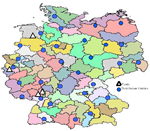
Placard Topic Part I: A Depot Loation - Allocation Problem
Registration By: Prof. Dr.-Ing. B. Noche, ALDARRAT, Hatem room MD 332
The Location/Allocation Problem deals with geographically placing a given number of warehouses so that the total distance traveled to customer sites is minimized. Though several well known algorithms such:
Covering Problems; P Center; P Median; Fixed Cost; Metaheuristics
Can be used to find good solutions, this problem can be complicated by including the items that need to be stored at each location.
In this case, two elements to the problem.
Location: Where to put the central facilities (and possibly how many, how big)
Allocation: Which subsets of the demand should be served from each site
Objectives: Cost of operating the facilities - includes construction, operating costs - may be independent of locations chosen; cost of travel to and from facilities - may be absorbed by the consumer or the provider depending on the context; quality of service; different objectives define different versions of the location-allocation problem.
• A Survey about the heuristics algorithms and techniques
• Constructing the algorithm and method framework
• Comparing and Evaluating the results with the benchmarking problems
Hint: Programming experience in one of the common programming language is essential.
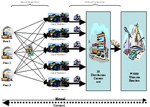
Placard Topic Part II: Model Cost Analysis (Activity Based Costing)
Registration By: Prof. Dr.-Ing. B. Noche, ALDARRAT, Hatem room MD 332
Usually, Manufacturers of consumer goods make use of a service provider for the distribution of their goods. The finished products are provided for delivery either in a warehouse associated with the factory or in a central warehouses, which consolidates the products of several factories , Larger shipments are either picked up from the factory or central warehouses and delivered directly as "TL" cargo to customer without intermediate transshipment operations , Smaller shipment are usually shipped through parcel services , which allow for cost effective delivery of shipments form factories or central warehouse to retail outlets.
The following steps should be done:
• A Survey about the heuristics algorithms and techniques
• Constructing the algorithm and method framework
• Developing the program
• Comparing and evaluating the results with the benchmarking problems
Hint: Programming experience in one of the common programming language is essential

Placard Topic Part III: Discrete Shipment Times Minimize the Cost of Transport and Inventory at origin and Destination
Registration By: Prof. Dr.-Ing. B. Noche, ALDARRAT, Hatem room MD 332
The finished products are provided for delivery either in a warehouse associated with the factory or in a central warehouses , which consolidates the products of several factories, Larger shipments are either picked up from the factory or central warehouses and delivered directly as "TL" cargo to customer without intermediate transshipment operations , Smaller shipment are usually shipped through parcel services , which allow for cost effective delivery of shipments form factories or central warehouse to retail outlets. This Project investigates the transport of products e.g. from a factory to a warehouse, when shipments can start only at discrete times, e.g. a certain time of a day or a certain day in the week. The objective is to minimize cost for transport and for the inventory at the origin and at the destination. This problem arises in a multi-product production/distribution system, when the production and transportation schedules are independent.
The following steps should be done:
• A Survey about the heuristics algorithms and techniques
• Constructing the algorithm and method framework
• Comparing and evaluating the results with the benchmarking problems
Hint: Programming experience in one of the common programming language is essential

Placard Topic Part IV: Strategic Logistical Network Design (Simulation Approach)
Registration By: Prof. Dr.-Ing. B. Noche, ALDARRAT, Hatem room MD 332
The process of creating competitive logistics network is often very complex: a range alternative network needed to be developed, analyzed and compared: a wide variety of quantitative and qualitative criteria are considered and several parties with differing functional backgrounds and differing disciplines are involved. A framework has been presented by Hagdorn, Meijden and Nunen for logistics network design, which as enhances the quality of the design process as well as the quality of the resulting network. Based on that we develop our framework for logistics network design, the framework starts with an analysis of a German company data from the ERP system. Via this analysis a simulation model using Dosimis-3 is developed. The distribution choices and scenarios are combined to lead to the developments of alternative logistics networks.
The following steps should be done:
• A Survey about the heuristics algorithms and techniques
• Constructing the algorithm and method framework
• Comparing and evaluating the results with the benchmarking problems
Hint: Programming experience in one of the common programming language is essential

Placard Topic Part V: Strategic Logistical Network Design (Mathematical Programming Approach)
Registration By: Prof. Dr.-Ing. B. Noche, ALDARRAT, Hatem room MD 332
The process of creating competitive logistics network is often very complex: a range alternative network needed to be developed, analyzed and compared: a wide variety of quantitative and qualitative criteria are considered and several parties with differing functional backgrounds and differing disciplines are involved. A framework has been presented by Hagdorn, Meijden and Nunen for logistics network design, which as enhances the quality of the design process as well as the quality of the resulting network. Based on that we develop our framework for logistics network design, the framework starts with an analysis of a German company data from the ERP system. Via this analysis a simulation model using Dosimis-3 is developed. The distribution choices and scenarios are combined to lead to the developments of alternative logistics networks.
The following steps should be done:
• A Survey about the heuristics algorithms and techniques
• Constructing the algorithm and method framework
• Comparing and evaluating the results with the benchmarking problems
Hint: Programming experience in one of the common programming language is essential
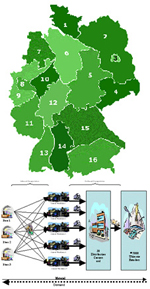
Placard Topic Part VI: A Depot Loation - Allocation Problem
Registration By: Prof. Dr.-Ing. B. Noche, ALDARRAT, Hatem room MD 332
The conflict between keeping inventory low to minimize inventory cost and the need to have products available for customers at the right place and the right time. This problem is exacerbated when products have a high cost per unit and customer service requirements are high. This problem is examined for a major international manufacturer. A logistical decision support tool will be developed to assist the organization in deciding where products & parts should be inventoried and in what quantity to minimize total inventory and logistics cost, while meeting a demanding customer service requirement. Many organizations have wrestled with the issues of inventory locations and stocking levels. When it is critical to have inventory available for customers, the traditional approach has been to place a large amount of inventory at all locations. Carrying an excessive amount of inventory achieves a high service level, but can be enormously costly, especially if the product has a high cost per unit. All organizations underestimate the cost of carrying inventory. In today's increasingly competitive marketplace organizations cannot afford to carry excessive levels of inventory. At the same time customer service, which includes having the product available for the customer at the right place and the right time, is increasingly important. To balance these two issues it is critical for an organization to set a service level goal and strategically plan their inventory logistics to achieve this goal at minimum cost. This critical issue was studied for a products & parts inventory where the organization had made a challenging service commitment of a certain predetermined response time.
The following steps should be done:
• A Survey about the heuristics algorithms and techniques
• Constructing the algorithm and method framework
• Comparing and evaluating the results with the benchmarking problems
Hint: Programming experience in one of the common programming language is essential
Diplomarbeit Marktanalyse und Funktionsweise von Standort-Auswahl-Tools
Interessenten melden sich bitte bei Hernn Prof. Dr.-Ing. B. Noche, Raum MD 329
Aufgabenstellung
Durchführung einer Marktanalyse von Softwaretools, die der Unterstützung einer Standortbestimmung von logistischen Distributionslägern dienen. Der theoretische Teil der Arbeit sollte die Funktionsweise, die hinterlegten Algorithmen sowie den Funktionsumfang solcher Tools darlegen.
Neben der Marktanalyse wird eine kritische Analyse über die Anwendbarkeit der Tools auf bestimmte Logistikfragen erwartet.
• Beginn: 01. August 2003
• Dauer: ca. 6 Monate
• Studiengang: BWL/VWL, Wirtschaftsingenieur, Logistik
Für die Bearbeitung der Aufgabenstellung sind: Interesse an logistischen Fragestellungen, Gute MS-Office Kentnisse, Operations Reseach Kentnisse, Gute Englischkenntnisse in Wort und Schrift erforderlich
Fachliche Fragen beantwortet Ihnen gerne Herr Marco Kohler, Telefon: +49 711 758-1668, E-Mail: marco.kohler@de.bosch.com
Bitte senden Sie uns Ihre Bewerbungsunterlagen - gerne auch per E-Mail - unter dem Kennwort "Marktanalyse Logistik" an:
ROBERT BOSCH
Geschäftsbereich Elektrowerkzeuge
Personalabteilung, Frau Schaich
Kennwort "Marktanalyse Logistik"
Postfach 10 01 56
70745 Leinfelden
Michaela.Schaich@de.bosch.com
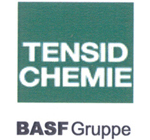
Aushang Die Tensid Chemie Köln (BASF-Gruppe) sucht Diplomanden und Praktikanten für den Bereich Logistik
Interessenten melden sich bitte bei Hernn Prof. Dr.-Ing. B. Noche, Raum MD 329
Folgende Aufgaben sind durchzuführen
• Lageranalysen
• Prozessanalysen
• Prozessoptimierung
• Bedarfsplanung
• Markt- und Leistungsanalysen
• Internationale Logistikkonzepte
Aushang Fahrzeuganzahldiagnose
Interessenten melden sich bitte bei Hernn Prof. Dr.-Ing. B. Noche, Raum MD 329
Aufgabenstellung
In vielen Betrieben in Industrie und Handel werden zur Lösung von logistischen Aufgabenstellungen fahrzeuggestützte Systeme eingesetzt, wie z. B.: Fahrerlose Transportsysteme, Stapler- und Schlepper-Hängerverbunde, Elektrohängebahnen. Typische Einsatzgebiete sind Montageversorgungen in der Automobilindustrie (Rohbau, Montage), Vorhaltung von Lager- und Kommissionierbereichen im Handel, innerbetrieblicher Transport in der Fertigung in Maschinenbauunternehmen und der chemischen Industrie. Einen besonderen Stellenwert nimmt dabei die Bestimmung und Abschätzung der Fahrzeuganzahl ein. Davon kann die Wirtschaftlichkeit einer ganzen Produktionsstätte abhängen. Darüber hinaus ist es oft schwierig, Rationalisierungseffekte in neue Technologien, wie z. B. aus dem Bereich der Informationslogistik, zu bewerten. Deshalb soll ein Softwareprogramm erstellt werden, das es gestattet, auf der Basis einfacher Dateneingaben (wie z. B. der Entfernungs- und der Transportintensitätsmatrix) Berechnungen und Grobsimulationen durchzuführen.
Im einzelnen müssen folgende Aufgaben bewältigt werden:
• Literaturrecherche über Algorithmen
• Analyse bestehender Programme
• Aufbau eines neuen Programms unter Windows
• Nachweis der Funktionalität an Beispielen aus der Praxis
Voraussetzungen: Für die Bearbeitung der Aufgabenstellung werden Grundkenntnisse der Programmierung erwartet.
Aushang Optimierung von Distributionsstrukturen
Interessenten melden sich bitte bei Hernn Prof. Dr.-Ing. B. Noche, Raum MD 329
Aufgabenstellung
Beim Aufbau von Distributionszentren im Handel, in der Konsumgüterindustrie, in der Ersatzteilversorgung von Automobilen, Elektrogeräten, Landmaschinen usw. müssen Logistiksysteme geplant werden, die ihre Aufgabe möglichst effizient erfüllen. Ein bisher ungelöstes Schlüsselthema ist dabei insbesondere die systematische Zuordnung von Artikeln zu entsprechenden Lagerbereichen. In der Regel besteht ein Distributionssystem aus verschiedenen Lager- und Kommissionierbereichen mit unterschiedlichen Leistungsfähigkeiten. Deshalb sucht die Industrie und der Handel verstärkt nach Methoden und Berechnungsprogrammen, die dieses Zuordnungsproblem unter Wahrung von vielfältigen Restriktionen lösen.
Im einzelnen sind folgende Aufgaben zu lösen:
• Literaturrecherche zur Zuordnungsproblematik
• Erstellung eines Lastenheftes (ggf. mit Industriepartnern)
• Entwicklung eines geeigneten Optimierungsverfahrens
• Implementation eines geeigneten Programms
• Nachweis der Funktionsfähigkeit des Konzepts anhand von Praxisbeispielen
Voraussetzungen: Für die Bearbeitung der Aufgabenstellung werden Grundkenntnisse der Programmierung erwartet.
Aushang Layoutoptimierung von Industriebetrieben
Interessenten melden sich bitte bei Hernn Prof. Dr.-Ing. B. Noche, Raum MD 329
Aufgabenstellung
Für die rationelle Abwicklung der Produktionsprozesse wird bei der Gestaltung der Fabriken ein optimiertes Layout für die Maschinenaufstellung und die Verkettung der Funktionsflächen benötigt. Dazu sind in der Vergangenheit eine Reihe von Softwareprogrammen erstellt worden, die die Aufgabenstellung jedoch nur unbefriedigend abdecken. Dies liegt daran, dass bei der Optimierung oft von festen Flächenvergaben ausgegangen wird - in der Praxis jedoch oft ein erheblicher Spielraum bei der Gestaltung des Layouts existiert. Mit Hilfe von modernen Optimierungsverfahren ist es jedoch möglich, die bisherigen Grenzen aufzuheben und der Industrie völlig neuartige Systemlösungen anzubieten.
Im einzelnen sind folgende Schritte zu bearbeiten:
• Literaturrecherche zum Thema Layoutoptimierung (Algorithmen)
• Marktanalyse Softwaresysteme (Layoutoptimierung)
• Erstellung eines Lastenheftes
• Auswahl von Optimierungsverfahren (evolutionsbasierte Verfahren)
• Prototyphafte Implementation einer Lösung
• Bewertung der Lösungsgüte anhand von Praxisbeispielen
Voraussetzungen: Für die Bearbeitung der Aufgabenstellung werden Grundkenntnisse der Programmierung erwartet.
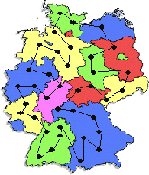
Placard Design of a Computerzied Traveling Salesman System
Registration By: Prof. Dr.-Ing. B. Noche, ALDARRAT, Hatem room MD 332
The Traveling Salesman Problem (TSP) requires that we find the shortest path visiting each of a given set of cities and returning to the starting point. Here's to design a program that lets you match our skill against the computer to define a path connecting a random set of cities together. There seems to be a lot of ongoing research on efficient techniques for solving TSP - the first solution of a 15,000 city case was just found in 2001, up dramatically from the landmark 49 city solution found in 1954. There are other application of the TSP beyond salesmen and school busses. For example: robotic travel problems like soldering or drilling operations on printed circuit boards, sequencing local genome maps to produce a global map, planning the order in which a satellite interferometer studies a sequence of stars, etc. Exhaustive search breaks down at something less than 15 cities (about a trillion, 1012, paths to check). When the number of cities exceeds the low teens, we'll have to rely on heuristic (rule of thumb) techniques which provide "pretty good" or "good enough" solutions. So that we have to develop a software program that can able to evaluate between these well known heuristics and techniques, which have been established for solving the TSP.
The following steps should be done:
• A Survey about the heuristics algorithms and techniqu
• Constructing the Software flowchart
• Developing the program under windows
• Comparing and Evaluating the results with the benchmarking problems
Hint: Programming experience in one of the common programming language is essential.
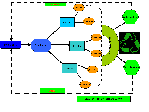
Placard Waste to Energy Supply Chain
Registration By: M. Sc. Fathi M. Amar Rhoma room MA 269
Over the last few decades local authorities have devoted increasing attention to waste disposal, because of its impact on the public concern for the environment. The rapid and constant growth in urban population led to a dramatic increase in urban solid waste production (annual waste production ranged from 300 - 800 kg per person a year), Energy consumption, with a crucial socio-economic and environmental impact. Furthermore, the depletion of the fossil fuel and increasing the Oil last few years led the increasing the attention to the waste management to improve the all supply chain as new Energy resource instead of environments defect. Municipal authorities often spend between 20-40 % of their budgets on cleaning and waste disposal. Furthermore, in a municipal solid waste management system, decreasing collection /hauling costs, which consist of 85% of total disposal expenditure, can be carried out by a route, location of the final waste treatment optimization and Energy recovery. Municipal solid waste collection (MSWC) is the beginning of the process of solid management which consists of generation, collection, transfer, treatment and final waste disposal. Integrated solid waste management involves a variety of programs and facilities, and incorporates source reduction, reuse, recycling, composting, incineration and landfilling. Therefore, if Route and location of the treatment plant optimization are performed in solid waste collection / hauling process, due to reductions in empty miles negativity, total expenditures will be decreased

Masterarbeit Darstellung und Optimierung der Klärschlammentsorgung der Wasserverbände
Interessenten melden sich bitte bei Herrn Dipl.-Ing Adel Al Mansi, Raum MA 269
Im Rahmen der Optimierung von Entsorgungswegen werden im Bereich der Abfallwirtschaft üblicherweise Stoffstromanalysen durchgeführt. Dabei werden die Stoffflüsse nach Ort und Menge erfasst, beschrieben und ihre Lenkung aufgezeigt. Diese Vorgehensweise ist auf alle Stoffe anwendbar, die einer Entsorgung zugeführt werden - so auch auf die Optimierung der Entsorgung von Klärschlämmen.
Zur Lösung dieser Problematik sollte zunächst für zwei ausgewählte Wasserverbände das Stoffstromsystem unter folgende Aspekte ausgewertet und optimiert werden:
• Quelle (Kläranlagen, Zwischenlager)
• Ziele (Zwischenlager, Klärschlamm-, Müllverbrennungsanlagen, Deponien, Kohlekraftwerke, Landwirtschaft,
Kompostierun)
• Transportmittel (Silofahrzeuge, Schiffe, Schienenfahrzeuge)
• Zeitliche Aufkommensstruktur
• Räumliche Entsorgungsstruktur (innerhalb/außerhalb NRW, Ökocity NRW)
• Struktur der vorhandenen/ freien Kapazitäten
• Routenoptimierung
• Standortoptimierung (Entwässerung,…)
